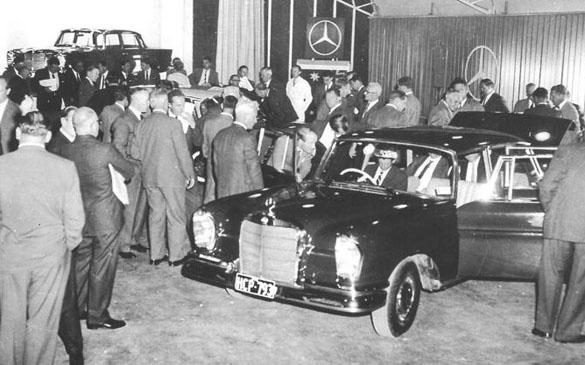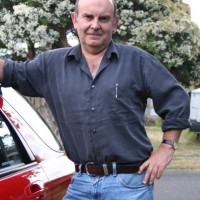
From 1959 until 1964, Mercedes-Benz passenger cars were built in Australia with significant local content. This period almost coincided with the early 1960 local launch of the W111 220S "finny" which was quickly followed by the fuel injected 220SE version in February 1960. Despite the cut in import duty, both models left little change out of $6000 at a time when a Holden Special, with a similar-sized six under the bonnet, cost $2300.
Local Mercedes-Benz sales until then struggled to top an exclusive 200 units per year. During the first full year of W111 sales from mid-1960 to mid-1961, this tally was boosted to a record 1481 units despite the hefty sticker. At least half this period also coincided with an Australian freeze on financing known as the Credit Squeeze. There was also a big boost in sales tax from 30 to 40 per cent (compared to today's 10 per cent GST) which decimated sales of other cars but not the 220S/SE.
Back in 1960, there were only a handful of options if you were spending a lazy $6000 on a new car in Australia. This money would buy a Jaguar MkII 3.4 or XK150 sports, one of the rare current model factory RHD De Soto, Dodge or Plymouth examples, a Porsche 356 Super 1600 Coupe or a Studebaker Hawk. And that was about it. A locally assembled Chevrolet Bel Air, the first sold here with the small block V8, cost just $4600, about the same as the locally recycled 1959 "tank" Fairlane 500.
You had to want a Mercedes-Benz W111 badly to walk past several of these. Other upper level six cylinder family cars comparable on paper and almost as desirable such as the Ford Zodiac and Vauxhall Cresta cost exactly half the 220SE. So what was driving this local sales boom?

Australians, including the recent flood of skilled European migrants, had left behind European war-time animosities quicker than most, even if it would take a while longer to reconcile past encounters with the Japanese. During the 1950s, German cars were well-represented in Australia after occupying British forces fast-tracked German self-sufficiency. Local companies moved quickly to form local assembly arrangements to get around the tough import restrictions of the times.
Volkswagen and Borgward had impressed Australians enough to warrant local assembly during the 1950s. The Goggomobil range was locally manufactured by Sydneysider Bill Buckle using local fibreglass copies of the German steel bodies along with the unique Australian Goggo Dart. Other Borgward models including the Lloyd-Hartnett (backed by former Holden founding chief Sir Laurence Hartnett) and Goliath-Hansa range had limited but strong followings. Along with the BMW motorcycle range, Australians valued the consistency in German engineering and quality under tough local conditions. The VW Beetle's success in the annual Redex Round Australia Trials during this period added credibility to the entire German industry.
The 1960 Wheels road test of the 220SE provides some insight into why it sold up a relative storm in 1960-61. It also sheds some light on why sales had slipped back to 1202 in 1964 despite a healthier market and the best automatic option in the business.
In early 1960, Wheels described the 220S "as one of the finest passenger cars ever built" then only months later had to admit they had "found a car that deserves the same words even more". This was the 220SE. The test kept referring to the slopmobile alternative, a thinly disguised reference to the FB Holden, a model that exposed Holden as taking its highly protected market for granted.

Wheels observed that the 220SE "would cruise all day at 160km/h" at a time when this was legal. It was backed by a fuel tank over 50 per cent bigger than the Holden and fuel economy 25 per cent better. The Holden ran out of puff at 136km/h and didn't have the brakes or the road holding to cruise at that speed.
The key to the 220SE's local appeal was the suspension that "absorbs bad roads as if they had been magically turned into the latest super highways" and brakes that showed "no signs of fade under the severest conditions". Add one of the earliest flow-through ventilation systems (the C-pillar extraction vents were not a Cortina first as they are clearly visible in the 220SE's C-pillars), the first passenger safety cell with "safety padding in every direction", night-driving centre mirror, "sizzling performance", long life, four speed manual with "unbeatable synchromesh" and Australia's first fuel injection system as previewed in the previous model, and the 220SE arrived with a real lead over any local offering regardless of price.
In 1960-62, it was certainly worth almost three Holdens in what it offered to anyone who lived beyond Australia's regional centres. It was also a shrewd long term investment in safety and mobility for a family on the land where the serious money was at that time. By 1964, the lack of any real change was starting to catch up with the styling and value for money equation as the price crept up to $6700.
Yet the 1202 sales were still respectable against the Holden EH Premier ($2840) that was infinitely more desirable than the 1960 FB range, Peugeot 404 ($2900), Citroen ID19 ($3400), local Dodge Phoenix ($5200), Chrysler AP5 Regal ($3000), Ford Fairlane 500 Compact ($4200), Studebaker Cruiser ($3400), Fiat 2300 ($3400), Triumph 2000 ($3100), Wolseley 6/110 ($4400), Humber Super Snipe ($4000), Rover 3-litre ($5600) and the amazing Jaguar 3.8 Mk II ($6000). Few of these were on offer on the 220SE's arrival in 1960 yet all were soon vying for the rural Aussie pound.
It is interesting to reflect on why a top W111 220SE still struggles to fetch more than many of these cheaper alternatives today. Could it be that the clinical efficiency, safety and long distance capabilities that made it so effective and desirable in 1960 no longer generate an X-Factor once these qualities became the norm in Australian family cars? Or was it because Mercedes-Benz kept it alive as an obsolete entry model 230S until the new compact range arrived in 1968?

The New Fin-Tail Mercedes-Benz
Australians were already familiar with the "roundie" 220S (and rare later 220SE) better known as the Ponton "a" range. The W111 was the "b" range hence the addition of a lower case b as in 220Sb and 220SEb to distinguish the two different series. Although the "roundie" mechanicals were similar, they were carefully refined for their latest application. The rear swing axle suspension was upgraded to the latest compensator spring design from the 300SL roadster which minimized camber change and oversteer, hence the glowing ride and handling reports.
After the new model broke cover in Europe in 1959, the big news was the 1961 replacement of the old Hydrak automatic clutch option with the benchmark four speed automatic, launched locally late in 1962. Front disc brakes arrived at around the same time.
When the new model was being defined in 1956, cars like the 1955-56 Chevrolet and forward look Chryslers were setting the global styling agenda. Company designers under Karl Wilfert set out to create a new international look that paid homage to the clean lines of the Italians and the tail fins on the rear of American models while providing a clear link with a long and proud past at the front.
For 1959, the curved front and rear glass and slender pillars were state of the art for a monocoque design. The detailing in the brightwork was exquisite. Elsewhere it was known as "heckflosse" or fintail. In Australia, it is known as a "finny". Although it didn't look it, it was bigger than the average Aussie family car in 1960 and was actually closer in size to the 1967 Chrysler VE Valiant on a similar wheelbase.
The most striking feature was the streamlined 'Lichteinheiten' front light units first seen on the 300SL roadster. These were a world first for a family car after they incorporated multiple front light functions in a single unit.

From just 2195cc, the 220SE's single overhead cam six delivered an outstanding 134bhp/100kW compared to the Holden's 75bhp/56kW from 2262cc, or about the same as the optional 3.6-litre engine in the 1968-70 XT-XW Falcon. Fuel economy averaged around 11L/100km at a time when sixes of this output struggled to post a 14L/100km average.
A prototype that combined the softer coupe tail and roofline with four doors could have been a handy facelift in 1963 as the tail fins were looking dated. This softer styling was held over for the larger new 250S/250SE models that arrived in Australia in early 1966. The previous W111 series was kept alive as a 230S until a new Compact range arrived two years later.
Local Production
The uncertainty of competing for import licences held by various local agents and the stiff import duty made it impossible for Mercedes-Benz to get traction in the local market. Unlike other locally assembled models which were made from SKD (semi knocked down kits), Mercedes-Benz needed a quality local operation to assemble its CKD (completely knocked down) kits. By 1957, the quality local assembly operation for Standard Vanguard and Triumph in Port Melbourne, Victoria was hurting. A revitalised Holden FE and Morris Minor 1000 eroded Vanguard and small Standard sales leaving spare production capacity.
The company's distribution network was also compatible with the target Mercedes-Benz market. The Vanguard had a strong rural following as a tough, four cylinder alternative to the Holden. After both companies identified mutual benefits, a new company Australian Motor Industries (which later provided the framework for Rambler and Toyota assembly before becoming Toyota Australia) was formed in 1958.

The first 220S "roundie" came off the line in March 1959. Bodies were assembled from scratch incorporating local tyres, batteries, leather seats, trim and paint. In their conservative grey hues tinted with white, green and graphite plus a black and a blue, there was a stoic practicality about these early cars broken by a welcome touch of leather and wood.
By the end of 1959, the "finny" was pressed into local production and the rest was history. Well, almost. Although AMI's production facilities were flat out meeting Mercedes-Benz demand, sales of the volume Vanguard and Triumph Herald models collapsed in 1960-61 from a combination of the Credit Squeeze and the flood of new rivals including the Ford Falcon, Anglia and a more competitive Morris-Austin range. To keep operations afloat, AMI had to relinquish their share in the local Mercedes-Benz operations and court Toyota.
The now wholly-owned factory-controlled Mercedes-Benz operation and distribution network contracted AMI to keep building local deliveries until 1964. However, the best case scenario of 1500 sales per year were not healthy enough to fund the 40 per cent local content required by then to win the necessary duty concessions.
For Australians, 1964 was a critical year as these requirements generated a new Chrysler factory to build the AP5 Valiant, Volkswagen expanded to produce an Aussie Beetle, and Holden manufactured its first small car, the Vauxhall Viva that evolved into the Torana. Mercedes-Benz was one of the many companies that had to revert back to importer or exit altogether. Local assembly ended in early 1965.
As has so often occurred since, it didn't hurt local sales one bit. By 1969, sales of imported Mercedes-Benz passenger cars had grown to 2317. The AMI experience and the "finny" had convinced Australians that the cars were a force to be reckoned with. The price premium was a safe bet when resale was so strong and the dealer network extended deep into rural areas. As Australia became one of the biggest world markets per capita for the 600 Grosser limousines, there was real confidence that Mercedes-Benz, as a company and a vehicle, would outlive any competitor.



